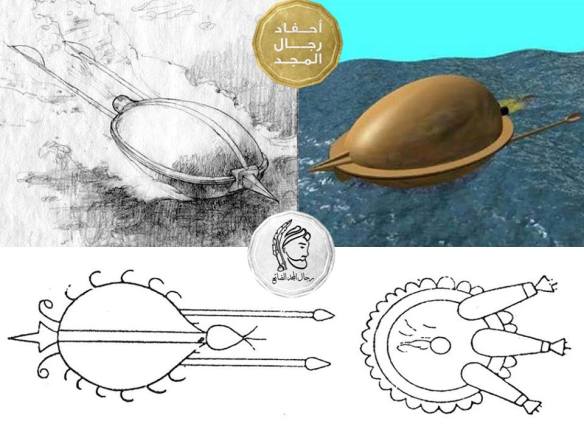It was invented by Arab inventor named Hassan Al Rammah between 1270 and 1280, who worked in Syria after the Mongol destruction of Baghdad. He wrote a treatise on gunpowder and rockets called “The Book of Military Horsemanship and Ingenious War Devices”. This book included more than 100 recipes for gunpowder, as 22 of them could be used as rocket fuel. Experts state that at least one of these recipes is extremely close to the modern ideal mix for gunpowder. Al Rammah also designed an early torpedo, probably the first of its kind.
Hassan Al-Rammah describes various kinds of incendiary arrows and lances and describes and illustrates what has been supposed to be a torpedo. This is called ‘the egg, which moves itself and burns’ and the illustration and text suggest at least that it was intended to move on the surface of water. Two sheet iron pans were fastened together and made tight by felt; the flattened pear-shaped vessel was filled with “naphtha, metal filings, and good mixtures (probably containing saltpetre), and the apparatus was provided with two rods (as a rudder?) and propelled by a large rocket.
The torpedo was named Al-Rammah and it was a point-and-fire weapon far cheaper and more efficient than a fire ship. When activated, the torpedo’s built-in pair of rockets would push it through the water, and tail stabilizers would direct it to the target. A spear on the front would impale itself in the hull of an enemy ship, and then the whole first-of-a-kind torpedo would explode.
The published work of Professor Ahmad Y. Al-Hassan and Donald R. Hill in their book, Islamic Technology (Cambridge University Press and UNESCO, 1986), and the more recent edition in paperback, 1992, further illustrates the importance of the man and his achievements.
Hasan Al-Rammah’s torpedo, from Islamic Technology: An Illustrated History, by al-Hassan, Ahmad Y., and Donald R., Hill.
These sources make it clear the birth of torpedo warfare and water-borne explosive devices did not happen in 1585 during the Dutch Eighty Years War as is commonly believed, but 300 years previously in Syria during the Mamluk period. (Hasan al-Rammah was a Syrian engineer living in the 13th century. At that time, Syria was part of the Mamluk Kingdom.)
This is a great discovery that has been at last brought to light.
